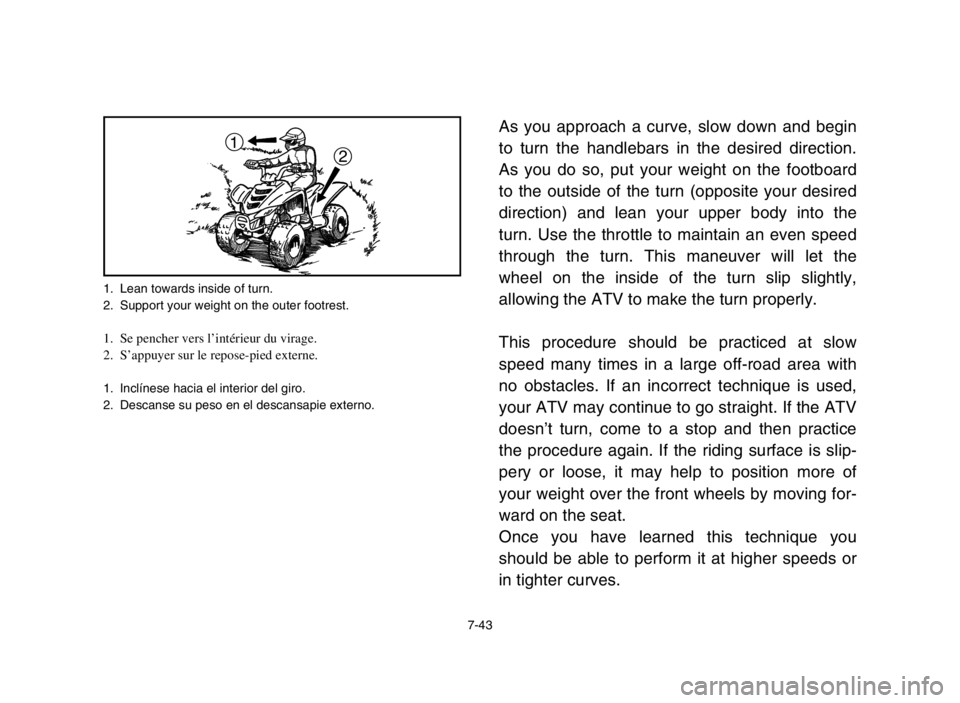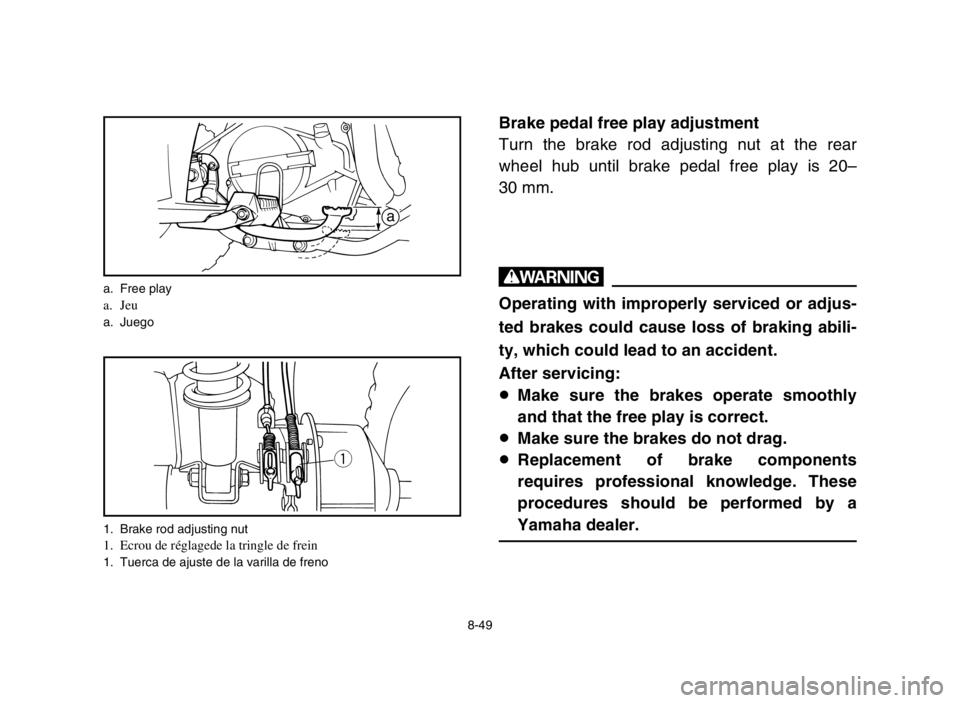wheel YAMAHA YFM80R 2005 Notices Demploi (in French)
[x] Cancel search | Manufacturer: YAMAHA, Model Year: 2005, Model line: YFM80R, Model: YAMAHA YFM80R 2005Pages: 343, PDF Size: 5.94 MB
Page 195 of 343

7-39
cC
Do not shift gears without releasing the
throttle. Damage to the engine or drive train
may occur.
When slowing down or stopping, release the
throttle and apply the brakes smoothly and
evenly. As you slow down, shift to a lower gear.
Be sure that the engine has sufficiently slowed
before engaging a lower gear. Improper use of
the brakes or shifting can cause the tires to lose
traction, reducing control and increasing the
possibility of an accident.
w
Make sure the engine has sufficiently slowed
before shifting to a lower gear. Engaging a
lower gear when the engine speed is too
high could cause the wheels to stop rotating.
5TH-9-63 7 17/3/04 11:25 AM Page 182
Page 197 of 343

7-41
TURNING YOUR ATV
To achieve maximum traction while riding off-
road, the two rear wheels are mounted solidly
on one axle and turn together at the same
speed. Therefore, unless the wheel on the
inside of the turn is allowed to slip or lose some
traction, the ATV will resist turning. A special
turning technique must be used to allow the ATV
to make turns quickly and easily. It is essential
that this skill be learned first at low speed.
w
Always follow proper procedures for turning
as described in this Owner’s Manual.
Practice turning at low speeds before
attempting to turn at faster speeds. Do not
turn at speeds too fast for your skills or the
conditions.
5TH-9-63 7 17/3/04 11:25 AM Page 184
Page 199 of 343

1. Lean towards inside of turn.
2. Support your weight on the outer footrest.
1. Se pencher vers l’intérieur du virage.
2. S’appuyer sur le repose-pied externe.
1. Inclínese hacia el interior del giro.
2. Descanse su peso en el descansapie externo.
7-43
As you approach a curve, slow down and begin
to turn the handlebars in the desired direction.
As you do so, put your weight on the footboard
to the outside of the turn (opposite your desired
direction) and lean your upper body into the
turn. Use the throttle to maintain an even speed
through the turn. This maneuver will let the
wheel on the inside of the turn slip slightly,
allowing the ATV to make the turn properly.
This procedure should be practiced at slow
speed many times in a large off-road area with
no obstacles. If an incorrect technique is used,
your ATV may continue to go straight. If the ATV
doesn’t turn, come to a stop and then practice
the procedure again. If the riding surface is slip-
pery or loose, it may help to position more of
your weight over the front wheels by moving for-
ward on the seat.
Once you have learned this technique you
should be able to perform it at higher speeds or
in tighter curves.1
2
5TH-9-63 7 17/3/04 11:25 AM Page 186
Page 209 of 343

7-53
If your ATV has stalled or stopped and you
believe you can continue up the hill, restart care-
fully to make sure you do not lift the front wheels
which could cause you to lose control. If you are
unable to continue up the hill, dismount the ATV
on the uphill side. Physically turn the ATV
around and then descend the hill.
If you start to roll backwards, DO NOT use the
rear brake to stop or try to put the ATV in gear.
The ATV could easily tip over backwards.
Instead, apply the front brake gradually, or dis-
mount the ATV immediately on the uphill side.
5TH-9-63 7 17/3/04 11:25 AM Page 196
Page 217 of 343

7-61
CROSSING A SLOPE
Traversing a sloping surface on your ATV
requires you to properly position your weight to
maintain proper balance. Be sure that you have
learned the basic riding skills on flat ground
before attempting to cross a sloping surface.
Avoid slopes with slippery surfaces or rough ter-
rain that may upset your balance.
As you travel across a slope, lean your body in
the uphill direction. It may be necessary to cor-
rect the steering when riding on loose surfaces
by pointing the front wheels slightly uphill. When
riding on slopes be sure not to make sharp turns
either up or down hill.
5TH-9-63 7 17/3/04 11:25 AM Page 204
Page 227 of 343

7-71
SLIDING AND SKIDDING
Care should be used when riding on loose or
slippery surfaces since the ATV may slide. If
unexpected and uncorrected, sliding could lead
to an accident.
To reduce the tendency for the front wheels to
slide in loose or slippery conditions, positioning
your weight over the front wheels will sometimes
help.
If the rear wheels of your ATV start to slide side-
ways, control can usually be regained (if there is
room to do so) by steering in the direction of the
slide. Applying the brakes or accelerating is not
recommended until you have corrected the
slide.
5TH-9-63 7 17/3/04 11:25 AM Page 214
Page 231 of 343

7-75
WHAT TO DO IF ...
This section is designed to be a reference guide
only. Be sure to read each section on riding
techniques completely.
WHAT TO DO ...
8If your ATV doesn’t turn when you want it to:
Bring the ATV to a stop and practice the turn-
ing maneuvers again. Be sure you are putting
your weight on the footboard to the outside of
the turn. Position your weight over the front
wheels for better control. (See pages 7-41–
7-45.)
8If your ATV begins to tip while turning:
Lean more into the turn to regain balance. If
necessary, gradually let off the throttle and/or
steer to the outside of the turn. (See pages
7-41–7-45.)
5TH-9-63 7 17/3/04 11:25 AM Page 218
Page 244 of 343

8-8 * Since these items require special tools, data and technical skills, have a Yamaha dealer perform the service.INITIAL EVERY
month 1 3 6 6 12
ITEM ROUTINEWhichever
km 320 1200 2400 2400 4800 comes first
(mi) (200) (750) (1500) (1500) (3000)
hours 20 75 150 150 300
Engine oil9Replace (warm engine before draining).2222
Final gear oil9Check oil level/oil leakage.
22
9Replace every 12 months.
Brakes*9Check operation.
22222
9Adjust if necessary.
Clutch*9Check operation.
2222
9Adjust if necessary.
Wheels*9Check balance/damage/runout.
2222
9Replace if necessary.
9Check bearing assemblies for looseness/
Wheel bearings*damage.2222
9Replace if damaged.
9Check operation.
Steering system*9Replace if damage.
22222
9Check toe-in
9Adjust if necessary.
Knuckle shafts/9Lubricate every 6 months with lithium-soap-based
222
steering shaft*grease.
Fittings and fasteners*9Check all chassis fittings and fasteners.
22222
9Correct if necessary.
9Check specific gravity.
Battery*9Check breather hose for correct routing.22222
9Correct if necessary.
5TH-9-63 8 17/3/04 11:24 AM Page 8-8
Page 283 of 343

8-47
EBU03361
Rear brake lever and brake pedal adjustment
Brake lever free play adjustment
1. Loosen the brake cable locknut.
2. Turn the adjusting bolt at the brake lever
until brake lever free play is 5–8 mm.
3. Tighten the locknut.
NOTE:
If specified free play cannot be obtained, tighten
the brake cable adjusting nut at the rear wheel
hub until brake lever free play is 5–8 mm.
wqa
q
1. Locknut 2. Adjusting bolt1. Contre-écrou 2. Boulon de réglage1. Contratuerca 2. Perno de ajustea. Free playa. Jeua. Juego
1. Brake cable adjusting nut
1. Ecrou de réglage du câble de frein1. Tuerca de ajuste del cable de freno
5TH-9-63 8 17/3/04 11:24 AM Page 8-47
Page 285 of 343

8-49
Brake pedal free play adjustment
Turn the brake rod adjusting nut at the rear
wheel hub until brake pedal free play is 20–
30 mm.
w
Operating with improperly serviced or adjus-
ted brakes could cause loss of braking abili-
ty, which could lead to an accident.
After servicing:
8Make sure the brakes operate smoothly
and that the free play is correct.
8Make sure the brakes do not drag.
8Replacement of brake components
requires professional knowledge. These
procedures should be performed by a
Yamaha dealer.
a
q
a. Free playa. Jeua. Juego
1. Brake rod adjusting nut
1. Ecrou de réglagede la tringle de frein1. Tuerca de ajuste de la varilla de freno
5TH-9-63 8 17/3/04 11:24 AM Page 8-49